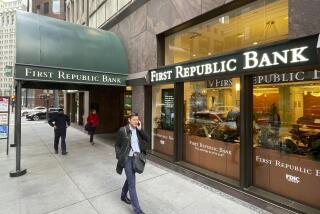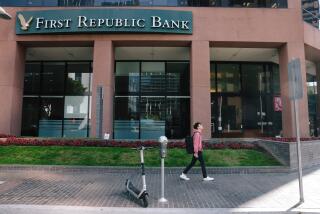Fed takes on a wider role
WASHINGTON — The Federal Reserve’s extraordinary move to rescue a tanking investment giant and expand its emergency lending appeared to pay off Monday. Although most U.S. markets showed fresh signs of strain, none snapped, and while some banks and Wall Street firms saw their stocks pummeled, none collapsed.
The question for the central bank now is whether its new policies will calm a jittery global marketplace for more than a day and whether it can reassure American taxpayers they won’t end up holding the bag.
By putting up its own funds to back a takeover of Bear Stearns Cos., the central bank moved into territory normally left to the private sector and embarked on one of the greatest expansions of its lending authority since the Great Depression.
Analysts and Fed officials sought Monday to dispel fears that the central bank was taking on too much risk as it scrambles to halt a credit crisis that threatens to plunge the country into a long and damaging recession.
“The Fed is not your normal corner bank,” said Mark Zandi, chief economist of forecasting firm Moody’s Economy.com in West Chester, Pa. “They set the rules, and they can set them just about any way they want.”
“The Fed is playing its classic role as lender of last resort,” said economist David M. Jones, a veteran observer of the central bank. “They’re absorbing some stresses so the credit markets can keep working.”
In a further effort to buoy the flailing economy, the central bank is expected to drop its benchmark interest rate by as much as a full percentage point to 2% when Fed policymakers meet today. That would make the rate’s decline over the last six months one of the swiftest in two decades.
As unusual as the Fed’s current rate policy is, the key controversy Monday centered on its decision to lend $30 billion to JPMorgan Chase & Co. to help consummate a fire-sale purchase of Bear Stearns, and a move to begin lending directly to large nonbank financial firms for the first time since 1936.
Both strategies set precedents that are likely to be tested quickly.
For the last 70-plus years, the Fed has lent only to banks. By enlarging its circle of eligible borrowers, the central bank has enlarged the potential demands on its resources. Several substantial financial firms, including Ohio’s biggest bank, National City Corp., saw their share prices nose-dive Monday, raising questions about whether the Fed or other government agencies will have to underwrite more shotgun weddings.
Meanwhile, many market players continued to park money in the perceived safe haven of Treasury securities rather than lending or investing it, making it increasingly likely that banks and other financial firms will have to turn to the Fed for funds, rather than getting them from one another as they usually do.
The danger in both cases is that the central bank could end up being the nation’s chief financier, a role that it was not designed to play and its leaders dearly hope to avoid.
Whether the Fed would have the wherewithal to handle repeated collapses and whether it can keep pumping credit into the economy to carry it past the current crisis were matters of fierce debate Monday. At issue is exactly how large are the central bank’s current resources and whether it could continue operating if it blew through them.
If the Fed can achieve its goals with the resources already at its disposal, then economic stability could be achieved without dumping new burdens onto taxpayers. The danger of a broad meltdown in the global financial system would recede, and the underlying strength of the U.S. economy could begin to reassert itself, averting or cutting short a damaging recession.
Clearly, that is the aim of the central bank’s leaders.
Critics argue that the Fed’s freedom of action is limited by the size of its portfolio of Treasury securities, which is essentially the only financial instrument that federal law allows it to buy outright. At $709 billion as of Thursday, the portfolio is hardly chump change.
But it is dwarfed by the size of the country’s financial markets.
“The Fed has enormous resources, but they are not infinite,” said Gregory Hess, a former Fed economist and the dean of the faculty at Claremont McKenna College.
According to some estimates, the Fed’s efforts so far to rescue the economy have locked up as much as $430 billion, or 60%, of the total. But the real amount spoken for could be only about $160 billion.
The main reason for the discrepancy is that in the last week the Fed unveiled two similar ways for its so-called primary dealers -- the 20 major financial firms through which the central bank conducts business -- to borrow from it using hard-to-sell mortgage-backed securities as collateral.
Under a plan unveiled a week ago, the dealers would be able to borrow from the Fed as much as $200 billion of Treasury securities for 28 days at a time.
Under the second plan, announced Sunday, the Fed would lend cash through a series of short-term loans similar to those it makes to banks at its so-called discount window.
Fed officials told reporters during a conference call Sunday night that for the time being they intended to suspend the first program and concentrate solely on the second.
But even the hundreds of billions of dollars at the Fed’s disposal doesn’t represent a limit on the Fed’s activities, according to central bank officials and veteran Fed analysts.
Although officials make clear they would use this power only in an emergency more extreme than the one the country now faces, the Fed has the capacity to create a near-infinite amount of credit.
Even under such desperate circumstances, analysts said, taxpayers should not get stuck with the bill. The only circumstance under which a taxpayer bailout might occur would be if creditors of the banks and financial firms to which it lends no longer believed the central bank would make good on its obligations.
Although “I’ve learned not to say ‘never’ after the last few months,” one senior official said, taxpayers haven’t had to bail out the Fed for any of its lending over the near-century of its existence, so they’re unlikely to have to do so now.
--
More to Read
Inside the business of entertainment
The Wide Shot brings you news, analysis and insights on everything from streaming wars to production — and what it all means for the future.
You may occasionally receive promotional content from the Los Angeles Times.










